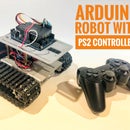Introduction: 3D Printed Articulating LED Lamp
Featured design on Thingiverse.com!
Runner up winner of Instructables Plastics Contest!
*** Update (26/09/2017): New thing files added:
Arms with three different sizes: 100, 140 and 200 mm. New arm type: mixed arm design (hole at one end and a stud at the other). With this you can extend the reach of the lamp one arm at a time (rather than needing a pair of arms). This may replace the other two types of arms (male and female).
Having good lighting at your desk or at a reading location is essential for your visual comfort and the health of your eyes. Although, it is not always possible to find a lamp of your liking, or that does not occupy much space on your desk, limiting your work area. In this Instructable I show how to make a 3D printed articulating lamp, which can be configured according to your needs.
Possibly the final product will be more expensive than ordinary lamps that you will find in stores. But none will be configurable like this, nor will will let you be proud to say that you did it by yourself! If you have a 3D printer or have access to one in your hacker/maker space, this is an interesting and useful project to equip your workshop and practice your 3D printing and modeling skills.
In the following steps I'll show how I adapted Kenneth awesome Articulating, Wall-Mounted, Magnetic Phone Mount design into an articulating wall mounted LED lamp.
Be careful when working with electricity. Make sure there is no short circuit and just try to connect to the electrical power plug after making sure that all components are properly connected and double insulated. If you don't have enough experience working with electricity, as for others help.
Don't touch any exposed wire or any metal part of the LED lamp after it's energized! Some LED spots have a metal heat sink. Avoid touching that part when the lamp is on!
Once there are exposed wires, it's not recommend to use it places accessible to children or animals. Under no circunstances use it close to wet surfaces!
It's and experimental design, so you might use it with caution.
Step 1: Tools and Materials
The following tools and materials were used in this project:
- 3D printer. In my case I used a Voolt3D, a Grabber i3 based 3D printer;
- 1.75mm PLA of different colors. I combined white and orange PLA in my design;
- Screwdriver. You'll need it for mounting your lamp on the wall and to assemble the electrical plug and switch;
- Screws (for mouting your lamp on the wall);
I used a 5W LED spotlight with a GU10 socket, similart to the ones bellow:
Don't forget to check its voltage.
You'll probably need some wires, a power plug and a on/off switch. You can find it in electrical hardware stores.
Please be carefull when working with electricity. It might be dangerous. Some of those connectors and LED bulbs might have exposed metal parts! Don't touch it's energized and keep it out of reach from children or pets. Make sure that everything is perfectly isolated beforing turning it on. If you have no experience working with electricity, ask for help of any one with experience, or use lower voltages (e.g. 5V LEDs).
Collect everything and get ready for some action!
Did you know you can buy a Anet A8 for only $169.99 at Gearbest? Get yours at http://bit.ly/2Hhkpz8.
Step 2: 3D Model
The 3d model was designed using Fusion 360, based on Kenneth's Articulating, Wall-Mounted, Magnetic Phone Mount desing. For this lamp I redesigned most of the parts using Fusion 360 and made some adaptations and simplifications to reduce the number of different components need to assemble the whole structure.
The model is composed of 8 different parts (some of them printed more then once as described bellow):
- Lamp holder - this is the part where the LED spotlight and it's connector are attached to the structure of the lamp;
- Arm (male) - one of the arms used on the structure. It has built in screws used to attach it to the female type arm;
- Arm (female) - another type of arm. It has whole in it's ends, which are used for the connection to another arm an to the base joint;
- Arm (mixed) - it has a hole at one end and a stud at the other. With this you can extend the reach of the lamp one arm at a time (rather than needing a pair of arms). This may replace the other two types of arms (male and female);
- Wall joint - it connects the arm to the wall mount using a 3d printed screw;
- Bolt - connects to the wall joint ot the wall mount
- Wall mount- used to attach the structure the wall.
Knobs (x4) - used for the fixation of each link.
You can download all the stl files from de following websites:
https://www.thingiverse.com/thing:4739055
https://www.myminifactory.com/object/43697
https://pinshape.com/items/38232-3d-printed-3d-printed-articulating-led-lamp
Step 3: 3D Printing
You'll have to print all the parts discribed on the previous step, in your favourite color. Notice that most of the parts are printed only once. Only the nut.stl will have to be printed four times.
I printed all the parts in PLA, with 0,2mm resolution and 20% infill.
Most of the parts won't need support if you print then in the right orientation (the on of the stl files). I only had to use supports for the lamp holder.stl.
You'll notice that my wall mount support is a little different than the one from the stl file. The part I printed has a small adaptation to allow it to fit into an existing wood panel in my office, so that I didn't have to use screws... Since not everyone's office has the same setup, I prefered to upload the stl part made for screw attachment.
Step 4: Mounting the Lamp
Once it's printed, mounting the structures is easy!
- Start from the wall mount part. The bolt passes through the wall mount and the wall joint parts and is locked with a knob on its end
- Attach the female arm (or a mixed arm) to the wall joint using a knob;
- Connect the male arm (or another mixed arm) to the female on with another knob;
- Attach the lamp holder to the other end of the male arm with another knob;
- Finally pass a LED spotlight through the lamp holder and put its connector.
Your structure will be ready to be attached to the wall.
Be careful when working with electricity. Make sure there is no short circuit and just try to connect to the electrical power plug after making sure that all components are properly connected and double insulated. If you don't have enough experience working with electricity, as for others help!
Don't touch any exposed wire or any metal part of the LED lamp after it's energized! Some LED spots have a metal heat sink, and some GU10 connectors have exposed metal. Avoid touching that part when the lamp is on! If necessary, cover it with isolating materials!
Step 5: Done!
It's done! Turn it on an let it shine!
You can adjust the angle between each component to make the spotlight aim the place you want to light up. You can even add extra arms and make it longer.
If you still don't follow my tutorials, take a look at those other projects in which I explain a little bit about internet of things, robotics and 3D printing. I hope you enjoy them too!
https://www.instructables.com/id/IoT-Wallet-smart-...
https://www.instructables.com/id/IoT-Air-Freshner-...
https://www.instructables.com/id/Minimalist-IoT-Cl...
https://www.instructables.com/id/IoT-Air-Freshner-...
https://www.instructables.com/id/Nunchuk-Controll...
Liked any of my projects? Please consider supporting my future projects with a small Bitcoin donation! :D
BTC Deposit Address: 1FiWFYSjRaL7sLdr5wr6h86QkMA6pQxkXJ

Runner Up in the
Plastics Contest

Participated in the
Home Improvement Contest 2017

Participated in the
Fix It Contest













